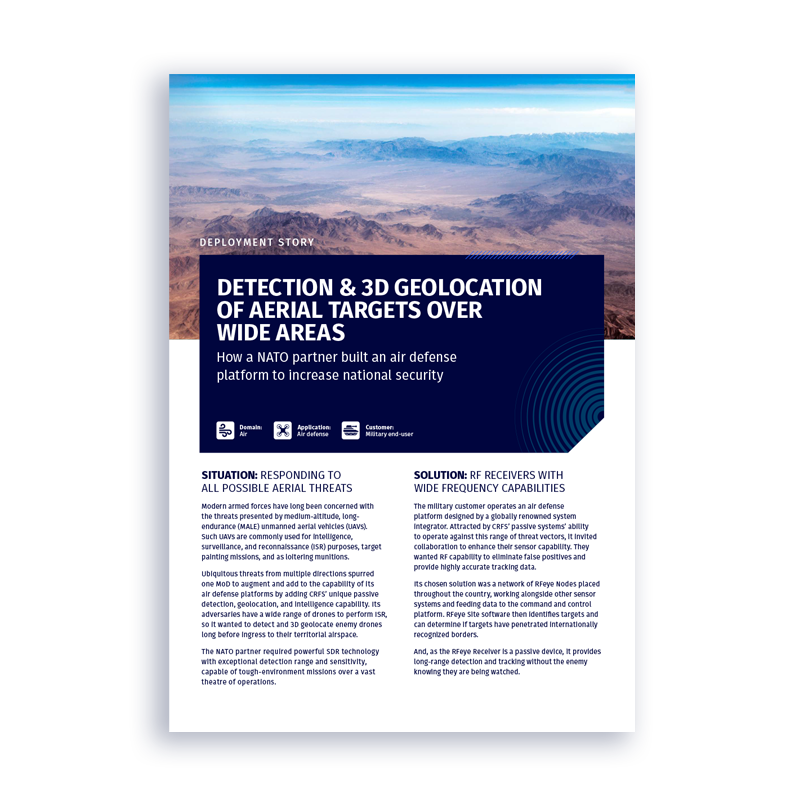New RFeye Site Release – Improvements for Enhanced Drone Detection

When combating hostile or unauthorized drones/UAS, the more warning an operator can get of a UAS/drone approaching, the greater the chance they will have of successfully countering any potential threat.
CRFS have been working with some key customers on how to extend their drone detection capabilities, and with the latest release of RFeye® Site (v1.50), our expert level spectrum monitoring software, we have added some new functionality that will help detect and geolocate drones with greater accuracy and range.
Improved TDOA accuracy with intelligent RFeye Node selection
In a large RFeye Node network, not all Nodes will be optimally positioned to geolocate a signal from a particular direction. As only three RFeye Nodes are needed to perform a TDOA geolocation (four Nodes for a 3D TDOA geolocation), v1.50 of RFeye Site takes incoming data from all the Nodes in the network, and automatically selects the best three/four Nodes to carry out the 2D or 3D TDOA geolocation. The selection of Nodes is determined by several factors including signal power and the location of the Nodes. The automatic Node selection delivers increased accuracy giving the operator confidence in the geolocation result.
Increased detection range with RFeye Node Antenna sequencing
In a sophisticated drone defense solution, an operator wants as much warning as possible of an approaching threat. By using a high-gain directional antenna facing the most likely direction of a potential threat, an operator can extend the detection and geolocation range. However, this would also mean that other directions wouldn’t be covered, and the facility would be left vulnerable.
RFeye Nodes have always had the capability to support multiple antenna types, including directional and omni, but now RFeye Site can now intelligently pick the best antenna to optimize detections. If the directional antenna picks up a drone signature, the signal can be automatically geolocated with TDOA. However, if the threat appears in a direction not covered by the directional antenna, the omni-directional antenna will still be able to detect and geolocate the signal as the drone moves towards the network.
Advanced warnings with Synthetic Vectors
With small COTS drones, the best TDOA geolocation systems are accurate to around 5km from the center of the network, this is because the RF power level used by COTS drones is relatively small. However, the latest release of RFeye Site extends the distance that COTS drone can be detected by providing the operator with information on the direction of an approaching drone before an accurate geolocation can be made. We call this a TDOA Synthetic Vector. Traditionally a vector, or line of bearing, is generated from Angle of Arrival (AOA) direction finding equipment, but now RFeye Site uses TDOA geolocation information to create a Synthetic Vector. It creates a line of bearing indicating the direction of the drone from the center of the network. The bearing information can also be fed into other 3rd party systems.
The Patented TDOA Synthetic Vector will give the direction of an approaching drone up to 10km from the center of the Node network. This early warning will help the operator to ensure they have other detection sensors, such as radar and EO, pointing in the correct direction as the drone approaches. Once the drone gets closer, RFeye Site will still be able to geolocate the drone in three dimensions and feed this data into any available countermeasure.
Above we can see a Synthetic Vector simulation that has been generated by a network of RFeye Nodes around an airport. The RFeye Nodes are attempting to geolocate the drone using TDOA, but RFeye Site is generating a Synthetic Vector based on the data received. As the drone moves closer it is being precisely geolocated using TDOA. This can also be seen in the video below.
And finally….
Creating Mission Automation Configuration (MAC) files in RFeye Site
As stated at the start of the blog, RFeye Site is our expert-level RF monitoring and geolocation tool. It is extremely powerful but requires input from an RF expert. This is the reason we created RFeye Mission Manager, our automated spectrum management tool. We wanted to keep RFeye Mission Manager simple to use, however there are times when you want to create automated schedules in RFeye Mission Manager that use some of the advanced configuration settings in RFeye Site. In RFeye Site v1.50, we have now added the ability to create a “mission” in RFeye Site and seamlessly export it into RFeye Mission Manager so it can be scheduled and run automatically. For example, if you wanted to use signal detectors with TDOA to geolocate a drone on a scheduled basis, you can create the configuration in RFeye Site, and then transfer it across to run in RFeye Mission Manager at the scheduled time and date. We’ll delve into this in more detail in subsequent blogs.
How to get the new features
To benefit from the enhanced features mentioned in this blog, customers will need to install RFeye Site v1.50, RFeye Mission Manager 2.6, and upgrade the Node firmware to version 1.20. These are all available to customers in the CRFS extranet. Learn more about our software updates on our release notes page.

Deployment story
Detection & 3d geolocation of aerial targets over wide areas
How a NATO partner built an air defense platform to increase national security
